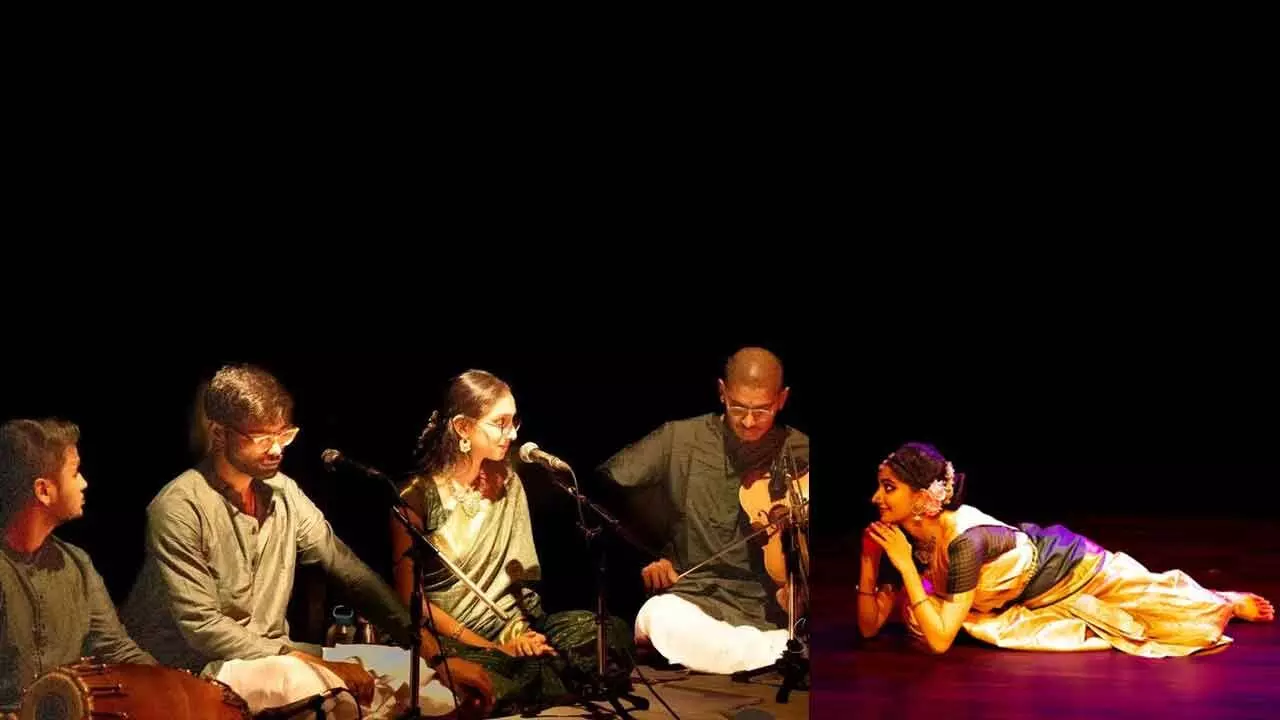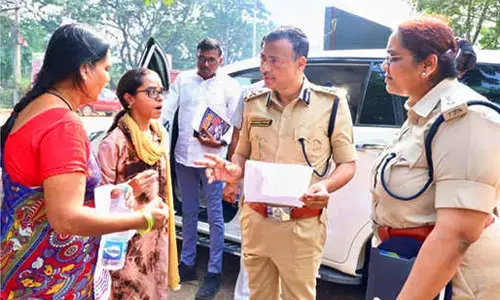Sahitya Ramkumar mesmerises with ‘Iti Kalyani’ at Rangbhoomi

Sahitya Ramkumar dazzled Hyderabad with her breathtaking Bharatanatyam performance “Iti Kalyani” at Rangbhoomi. The sold-out show featured her exceptional artistry and innovative choreography, leaving the audience spellbound and earning a standing ovation
Sahitya Ramkumar is rapidly making her name as an innovative and creative Bharatanatyam dancer in Hyderabad. Her undoubted talent will definitely take her places, as evidenced by the remarkable response to her productions. These performances are one of a kind and attract an overflowing audience. Her weekend ticketed solo program at Rangbhoomi was sold out, which is no mean feat for a young artiste and is a testament to her credibility to deliver an outstanding performance.
The title of this Sahityakalpa program, “Iti Kalyani,” summarized that the entire concept was devoted to the Queen of Ragas - Kalyani and allied Janya ragas, which share the regal name of their Parent. They have the same foundation but emit a distinctly different flavor of their own. Serenely melodious, silvery, and sparkling in all its derivatives, Kalyani is a favorite raga alike for composers and listeners.
The novel idea of assembling an entirely new team of equally talented young orchestra members was a masterstroke. A fresh vibrance and enthusiasm were infused, radiating throughout the recital. The verve and vigor of this team were evident: Divyasri Pisupati, an upcoming vocalist with flair who promises to make her mark; Sai Venkata Gangadhar, a brilliant Kuchipudi dancer who essayed nattuvangam for a different dance form with elan; Koundinya Pannala, whose mastery of the violin added zest; and finally, the Mridangam, played with incomparable wizardry by Veeramraju Lakshmi Ajay.
The credit for bringing together, monitoring, and superbly encouraging the entire team into giving their best must go to Sahitya. It should be understood that the effort put in by a dance orchestra is markedly different from that which performs for a concert. The demanding repetitions require a greater degree of coordination between different vocabularies to synchronize and achieve a complementing harmonious whole out of contrasting aural and visual realms.
The aharya was pared down to essentials: a palette of sandal cream, aureate rose bordered with green containing traceries of gold made for a softly luminous and refined elegance. A touch of pink flowers to the headdress with minimum emerald-toned jewelry subtly added refinement. The artiste looked picture-perfect and fascinated the audience as she resembled a chryselephantine (ivory & gold) statuette.
Sahitya gave a brief intro incorporating mimed gestures at the start, summing up the forthcoming program and touching on its nuances, which was a poetic act and instantly achieved its aim of setting the mood for the viewers. The rasikas sat back and enjoyed the theme of love’s blossoming and reveled in its beauty.
Jatiswaram and Alarippu blended seamlessly as they had a matching cycle of seven beats in Mishrachapu. In Mohana Kalyani, whose Aarohanam has the notes of Raga Mohanam and Avarohanam Kalyani, the Jatiswaram was a treat to watch in its joyful and youthful stride. The Alarippu was reimagined to vividly depict the image of a blossoming flower, and while both pieces adhered to the traditional diction, their juxtaposition in this particular idiom was imaginatively reinvigorating. The sublime “Sarasi JakshuduNeevani” varnam, a treasured priceless heirloom of Sivananda from the Tanjore Quartet, unfolded majestically. This baroque masterpiece was extensively re-choreographed with scintillating jathi sequences. It is structured as a love letter from the Nayika to her beloved Rajagopalaswamy. Sahitya’s heightened mastery of abhinaya was outstanding as she portrayed the exquisite ornate imagery which described the beauty of the beloved Lord with lotus petal eyes who is yearned for passionately.
All the lovelorn passion was brimming in the histrionics, reaching a peak as with fluttering eyes, throbbing body, and heartfelt gestures, the heroine was brought to life onstage, beseeching the embrace of her Lord. A segment encapsulated the temple chariot procession rituals. Charanam “Gana Vidya Lola” gave ample scope as it was better expressed musically rather than through movement for a brief interlude of a stirring vintage thani or solo instrumental segments. The rare Hamir Kalyani Thillana of Muthiah Bhagavathar with sahityam or lyrics in praise of Krishnaraja Wadiyar was brisk and colorfully done with sculpturesque jathis in perfect nritta. Fluid and lissomekaranas were the highlights here. Swati Thirunal Bhajan in Yaman Kalyani reached a crescendo of devotional ecstasy as Sahitya danced the Ras Leela to the ebb and flow of the music like the river Yamuna’s currents and “Krishna” played the flute! Padmanabha’s leelas, the poet says, are indescribable.
A standing ovation was given as the spellbound audience reluctantly awoke from the enchantingly lovely dream-like concept created by the artistes! The evening’s presentation was graced by the presence of renowned Bharatanatyam Maestro Padmashri Dr. Ananda Shankar Jayant.
















